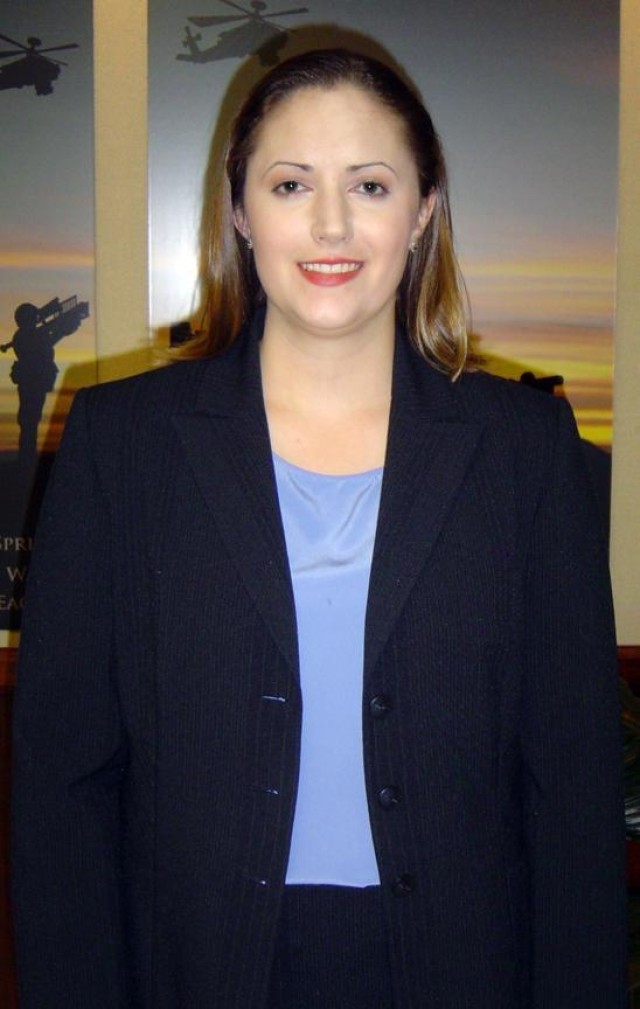<i>Streamlining results in cost avoidance</i>
In a seemingly incongruous recipe -- mix a Texas Longhorn with a Texas A&M Aggie -- the PEO Missiles and Space has produced a prize-winning and fund-saving hero in the person of Rachelle Lapperre.
Specifically, that Lone Star State blend is a Lean Six Sigma Black Belt, who has achieved an historical first and set the standard for her building 5250 teammates by becoming the program executive office's first certified Black Belt.
"She was very diligent throughout this project, and the entire PEO Missiles and Space applauds all of her efforts," the PEO's Frank DeLuca said. "Her tenacity has set the standard and her efforts totally align with Army's Business Transformation practices and Brig. Gen. (Genaro) Dellarocco's philosophy of Starting Every Day Lean."
An AMC fellow, Lapperre has slogged through a 13-month master's degree and is currently in year four of the five-year program.
"I have two career programs: Logistics and Program Management," the Texas native said. "But, in terms of the Texan-Aggie blend, it could be said that I crossed over to the Dark Side, became an Aggie, and emerged as a Black Belt."
In the PEO, a Black Belt crosses the finish line by completing the five LSS steps, ideally at the eight-month mark.
"The five LSS steps: Define, Measure, Analyze, Improve and Control mean that a trainee has to pay his or her dues at each 'toll gate' to get certified," DeLuca said. "The process owner, or Champion, in addition to a Board of Directors, assures that all requirements are met and satisfied at each of the five toll-gate evaluations."
The mechanics of the project's scope are integral to the entire effort.
"Discovering what is the best way to work this defined solution at each of the following four gates is key," DeLuca said. "Looking at options to maximize the solution is vital."
Staying within Control limits dictates if the Army reaps benefits, with the Assistant Secretary of the Army for Acquisition, Logistics and Technology as well as the Army Materiel Command writing the 'report card' on Control Limit benefits.
"A Black Belt is always measuring to assure that Control Limit - long-lasting fixes are maintained," Lapperre said. "That becomes part of the process; data will continue to be collected and charted on Hellfire M 299 and M272 missile launchers Reset."
She traveled with the Reset Team to the unit's locations for depot-level repairs. They worked launcher Reset at the Tennessee National Guard, in Boise, Idaho and at Fort Bragg, N.C., actually 'turning wrenches' on flight lines 12 hours per day, with eight-hour Saturdays.
"I do woodworking, so this was just using a different set of tools. I had a lot of fun and the guys were truly great," Lapperre said. "They were very supportive and did not get tired of answering all of my questions."
Using LSS proved to be the right tool, at the right time and at the right place.
"The team looked at the situation and arrived at a solution, thanks to Rachelle's second set of Black Belt-trained eyes," DeLuca said. "The result is a win-win situation; that is, the product is better for our war fighters and better for the work force."
Quickness and efficiency proved to be the hardware keys unlocked by using LSS tools.
"Rachelle had a 20-percent cycle time reduction goal at the outset, but actually came up with a 25-percent reduction and an annual cost avoidance of $94,000," DeLuca said. "She changed the flow of the operation to optimize the solution set. Basically, she sat down with the workers, asking them: 'Why are you doing that''"
A new set of eyes was the crucial linchpin.
"We used an industrial-standard spaghetti diagram to track the movement of people," Lapperre said. "I discovered that they spent about 45 minutes walking around to get parts during a 12-hour shift. I centralized the parts location and reorganized the layout, eliminating non-value-added actions and steps."
She also researched an automatic parts washer that incorporates a rust inhibitor to prevent corrosion, as well as designed a new test bench and other tools that make the Reset process easier and faster.
"My grandfather was a carpenter, who actually built his own house," Lapperre said. "I grew up working with my hands and basically thought it was fun, so this whole project was a natural for me. It was just a different set of tools and working with metal instead of wood."




Social Sharing